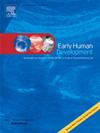Digit ratio (2D:4D) and maxillary sinus volume: A link between prenatal sex steroids and a paranasal reservoir of nitric oxide?
IF 2.2
3区 医学
Q2 OBSTETRICS & GYNECOLOGY
引用次数: 0
Abstract
Background
The paranasal sinuses serve as a reservoir for nitric oxide (NO), a vasodilator associated with cardiovascular health and exercise performance. Digit ratio (2D:4D), a proxy for first trimester testosterone and estrogen, is also a correlate of cardiovascular health and exercise performance. There are sex differences in the volume of fractional exhaled NO (FeNO: males>females) and in mean 2D:4D (males<females). Here we consider the relationships between 2D:4D and the volume of the largest paranasal sinus, i.e. the maxillary sinus (MS), in men and women.
Methods
30 male and 30 female participants, mean age of 38.4 ± 11.8 years, who had a paranasal sinus computer tomography (CT) scan were included. The MS volumes were calculated from the scans using GE software. The 2D:4D ratios were obtained from direct measurements of the 2nd and 4th digits.
Results
Sex differences were not significant in 2D:4D or MS volumes. In males, 2D:4D correlated negatively with right MS volume (right and left 2D:4D, r = −0.58) and left MS volume (right 2D:4D r = −0.45, left 2D:4D r = −0.40). After removal of the effects of age, BMI and digit length all correlations for the right MS remained significant as did that between right 2D:4D and left MS. There were no significant correlations in females.
Conclusion
We have found that low (androgenized) 2D:4D in men is associated with high MS volumes with stronger effects for the right MS. Our findings indicate that in men high prenatal testosterone relative to estrogen is related to high MS volume. We suggest that 2D:4D may be negatively related to FeNO volume produced by the MS.
手指比例(2D:4D)和上颌窦容积:产前性类固醇和鼻旁一氧化氮储存库之间的联系?
鼻窦是一氧化氮(NO)的储存库,一氧化氮是一种与心血管健康和运动表现相关的血管舒张剂。手指比例(2D:4D)是孕早期睾丸激素和雌激素的代表,也与心血管健康和运动表现相关。呼出一氧化氮的分数量(FeNO:男性>;女性)和平均2D:4D(男性<;女性)存在性别差异。在这里,我们考虑了2D:4D和最大的副鼻窦,即上颌窦(MS)的体积之间的关系,在男性和女性。方法选取经鼻窦计算机断层扫描(CT)的男性30例,女性30例,平均年龄38.4±11.8岁。使用GE软件从扫描中计算质谱体积。二维:四维比率是通过直接测量第二和第四指获得的。结果二维、四维和质谱体积的性别差异无统计学意义。在男性中,2D:4D与右侧MS体积(左右2D:4D, r =−0.58)和左侧MS体积(右侧2D:4D r =−0.45,左侧2D:4D r =−0.40)呈负相关。在去除年龄、BMI和手指长度的影响后,右侧MS的所有相关性仍然显著,右侧2D:4D和左侧MS之间的相关性也很显著。女性中没有显著相关性。我们发现男性低(雄激素化)2D:4D与高MS体积相关,对右侧MS的影响更强。我们的研究结果表明,男性产前高睾酮相对于雌激素与高MS体积有关。我们认为2D:4D可能与MS产生的FeNO体积负相关。
本文章由计算机程序翻译,如有差异,请以英文原文为准。
求助全文
约1分钟内获得全文
求助全文
来源期刊

Early human development
医学-妇产科学
CiteScore
4.40
自引率
4.00%
发文量
100
审稿时长
46 days
期刊介绍:
Established as an authoritative, highly cited voice on early human development, Early Human Development provides a unique opportunity for researchers and clinicians to bridge the communication gap between disciplines. Creating a forum for the productive exchange of ideas concerning early human growth and development, the journal publishes original research and clinical papers with particular emphasis on the continuum between fetal life and the perinatal period; aspects of postnatal growth influenced by early events; and the safeguarding of the quality of human survival.
The first comprehensive and interdisciplinary journal in this area of growing importance, Early Human Development offers pertinent contributions to the following subject areas:
Fetology; perinatology; pediatrics; growth and development; obstetrics; reproduction and fertility; epidemiology; behavioural sciences; nutrition and metabolism; teratology; neurology; brain biology; developmental psychology and screening.
 求助内容:
求助内容: 应助结果提醒方式:
应助结果提醒方式:


